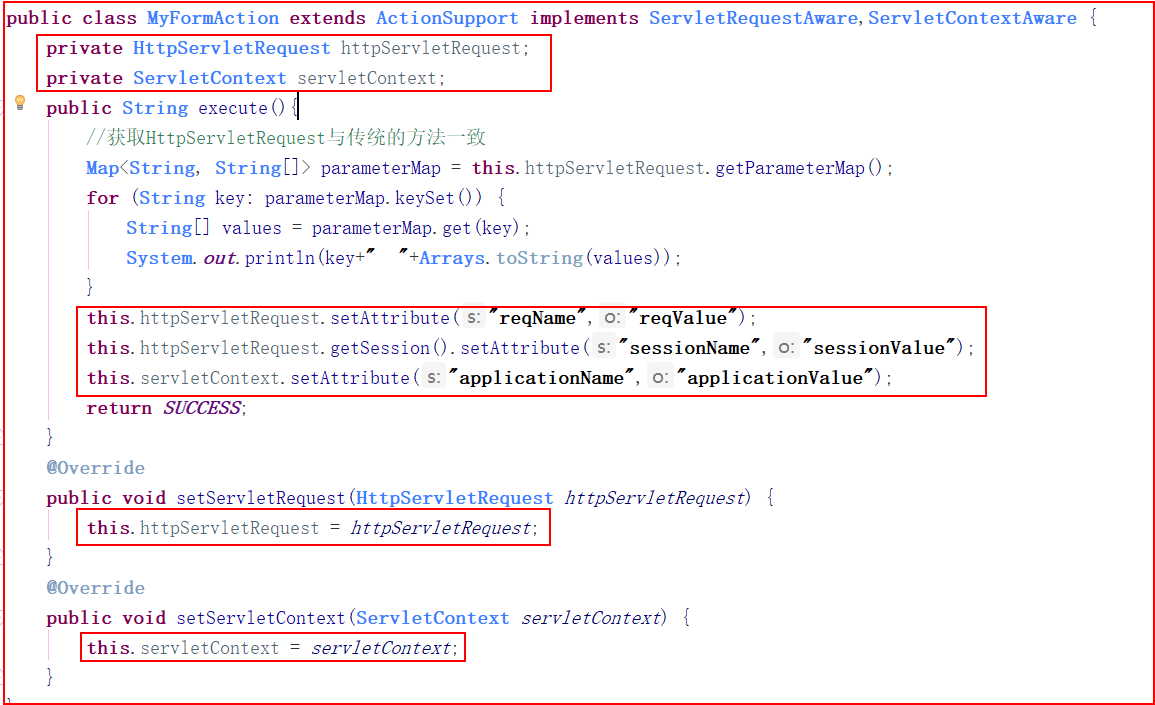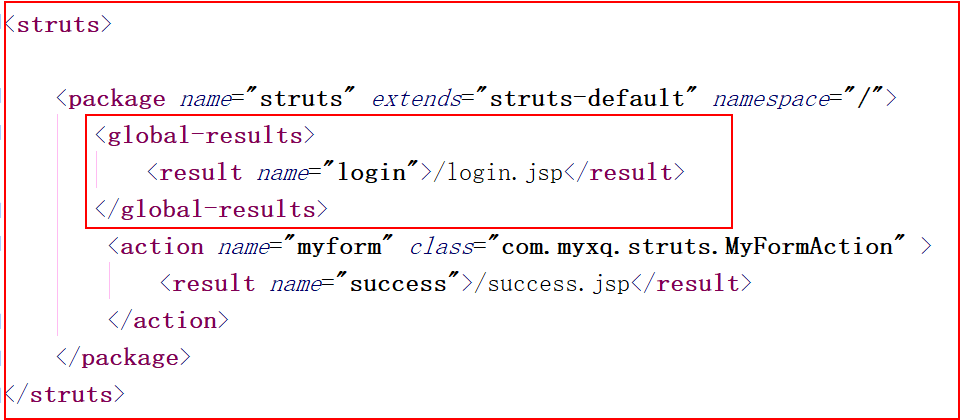Struts中API介绍
ServletAPI
在使用Struts2的框架的过程中,发现Struts2和Servlet的API是解耦合的。
在实际开发中,经常使用到Servlet的API,比如进行登录,将用户的信息保存到Session中,有的时候需要向页面输出一些内容,用到response对象。涉及到Servlet的API的访问。
如何获得到servlet中的API
完全解耦合的方式
- 使用ActionContext来进行获取
- 注意
- 此方法只能从域中取数据和保存数据
- 不能获取其它的方法
使用步骤
<form action="${pageContext.request.contextPath }/myform.action"
method="get">
用户名:<input type="text" placeholder="请输入用户名..." name="username"><br />
昵称:<input type="text" placeholder="请输入用户名..." name="nick"><br />
爱 好:
<input type="checkbox" value="足球" name="hobby">足球
<input type="checkbox" value="篮球" name="hobby">篮球
<input type="checkbox" value="乒乓球" name="hobby">乒乓球<br />
<input type="submit" value="提交">
</form><struts>
<package name="struts" extends="struts-default" namespace="/">
<action name="myform" class="com.xzh.struts2.MyFormAction">
<!-- 结果页 -->
<result name="success">/myxq.jsp</result>
</action>
</package>
</struts>public class MyFormAction extends ActionSupport {
public String execute() {
// 获取参数
ActionContext context = ActionContext.getContext();
HttpParameters parameters = context.getParameters();
// 根据key取值
String username = parameters.get("username").getValue();
System.out.println(username);
String nick = parameters.get("nick").getValue();
System.out.println(nick);
String[] hobbys = parameters.get("hobby").getMultipleValues();
System.out.println(Arrays.toString(hobbys));
// 获取所有参数
Set<Map.Entry<String, Parameter>> MapEntry = parameters.entrySet();
for (Map.Entry<String, Parameter> entry : MapEntry) {
System.out.println(entry.getKey());
System.out.println(Arrays.toString(entry.getValue().getMultipleValues()));
}
// 把数据存放到域中
context.put("resName", "resValue");
context.getSession().put("sessionName", "sessionValue");
context.getApplication().put("ApplicationName", "ApplicationValue");
return SUCCESS;
}
}<%@ page contentType="text/html;charset=UTF-8" language="java" %>
<html>
<head>
<title>Title</title>
</head>
<body>
<h1>myxq</h1>
res:${reqName }
session:${sessionName }
Application:${ApplicationName }
</body>
</html>示例表单
<form>
用户名:<input type="text" placeholder="请输入用户名..." name="username"><br/>
昵称:<input type="text" placeholder="请输入用户名..." name="nick"><br/>
爱 好: <input type="checkbox" value="足球" name="hobby">足球
<input type="checkbox" value="篮球" name="hobby">篮球
<input type="checkbox" value="乒乓球" name="hobby">乒乓球<br/>
<input type="submit" value="提交">
</form>使用Servlet的API的原生方式
- servletActionContext
- 这种方式可以操作域对象的数据,同时也可以获得对象的方法。
- 使用步骤
<form action="${pageContext.request.contextPath }/myform.action"
method="get">
用户名:<input type="text" placeholder="请输入用户名..." name="username"><br />
昵称:<input type="text" placeholder="请输入用户名..." name="nick"><br />
爱 好:
<input type="checkbox" value="足球" name="hobby">足球
<input type="checkbox" value="篮球" name="hobby">篮球
<input type="checkbox" value="乒乓球" name="hobby">乒乓球<br />
<input type="submit" value="提交">
</form><struts>
<package name="struts" extends="struts-default" namespace="/">
<action name="myform" class="com.xzh.struts2.MyFormAction">
<!-- 结果页 -->
<result name="success">/myxq.jsp</result>
</action>
</package>
</struts>public class MyFormAction extends ActionSupport {
public String execute() {
// 获取原生api
HttpServletRequest request = ServletActionContext.getRequest();
// 根据key取值
String username = request.getParameter("username");
System.out.println(username);
String nick = request.getParameter("nick");
System.out.println(nick);
String[] hobbys = request.getParameterValues("hobby");
System.out.println(Arrays.toString(hobbys));
// 获取所有参数
Map<String, String[]> parameterMap = request.getParameterMap();
for (String key : parameterMap.keySet()) {
String[] values = parameterMap.get(key);
System.out.println(key + " " + Arrays.toString(values));
}
// 把数据存放到域中
request.setAttribute("resName", "resValue");
request.getSession().setAttribute("sessionName", "sessionValue");
ServletActionContext.getServletContext().setAttribute("ApplicationName", "ApplicationValue");
return SUCCESS;
}
}<%@ page contentType="text/html;charset=UTF-8" language="java" %>
<html>
<head>
<title>Title</title>
</head>
<body>
<h1>myxq</h1>
res:${reqName }
session:${sessionName }
Application:${ApplicationName }
</body>
</html>接口注入的方式
让Action实现一些接口,让接口提供的一些方法,设置一些具体的值
使用步骤
结果页配置
全局配置
- 全局结果页面:全局结果页面指的是,在包中配置一次,
- 其他的在这个包中的所有的action只要返回了这个值,都可以跳转到这个页面。
使用场景
有些功能需要用户登入才能使用,只要没有登录,就让它返回到登录页面,很多地方都要返回到登录,所以可以把登录页做为一个全局的
使用方法

局部配置
局部结果页面:局部结果页面指的是,只能在当前的action中的配置有效
使用方法

注意点:全局和局部名称相同时,会优先找局部




 本文详细介绍了在Struts2框架中如何集成Servlet API,包括通过ActionContext获取API、使用servletActionContext操作域对象及接口注入方式。并提供了具体实例代码,展示了如何在Struts2中使用Servlet的API进行参数获取、数据存储等操作。
本文详细介绍了在Struts2框架中如何集成Servlet API,包括通过ActionContext获取API、使用servletActionContext操作域对象及接口注入方式。并提供了具体实例代码,展示了如何在Struts2中使用Servlet的API进行参数获取、数据存储等操作。

















 被折叠的 条评论
为什么被折叠?
被折叠的 条评论
为什么被折叠?








